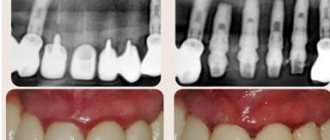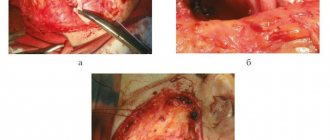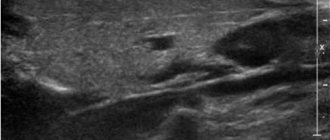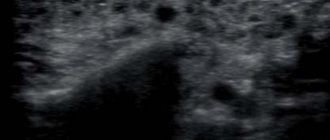Inflammation of the salivary glands is a dangerous condition that leads to indigestion, sudden weight loss and dehydration of the body. Dogs suffering from inflammatory processes become more lethargic and apathetic, they are prone to nervous disorders and aggressiveness. For information about what causes inflammation of the salivary glands and what symptoms indicate this, see below.
Read in this article
- What is this?
- Causes of diseases
- Symptoms of inflammation of the salivary glands
- Diagnosis and treatment
- Prevention
What is this?
Saliva production is an important part of digestion. Enzymes that are released during salivation simplify the swallowing process. A healthy dog produces about 1 liter of saliva per day, depending on weight and lifestyle.
Main major salivary glands:
- Parotid. They are located in the area of the ears, and their main feature is their small size;
- Submandibular. They are located in the back of the maxillofacial apparatus between several veins;
- Sublingual. They are located under the tongue and secrete saliva, which contains a protein secretion and is rich in mucin.
The secretion secreted by the salivary glands differs in its composition and functions. Inflammation of even one pair leads to painful and unpleasant sensations, as well as problems with the digestive system.
Symptoms
Clinical manifestations are characteristic and easily recognized:
- profuse drooling;
- the dog has difficulty swallowing;
- the pet refuses to eat;
- a swelling forms above the inflamed gland;
- the dog moves away when touched;
- the inflamed surface is hot;
- if suppuration develops, the dog suffers from pain and cannot sleep;
- the mouth is constantly slightly open, there is an unpleasant smell from it;
- tooth enamel darkens;
- plaque appears and tartar forms;
- gingivitis develops, which leads to tooth loss;
- the dog loses weight, the coat loses its metallic shine.
Causes of diseases
The most common reason that provokes the development of inflammatory processes in the salivary glands is infection. It can be of viral or bacterial origin. Remember: the sooner the cause is determined, the sooner treatment can begin.
Note! The high-risk group includes young individuals. This especially applies to several breeds: boxers, dachshunds, German shepherds and poodles.
The main causes of inflammation of the salivary glands:
- Injury
Blunt or penetrating injury to the salivary glands can lead to the development of inflammatory processes, especially if untimely or unprofessional assistance is provided.
- Penetration of foreign objects
Often, inflammation of the salivary glands is provoked by eating sharp or hard leaves, straws and other objects that can lead to blockage of the salivary ducts.
- Neoplasms
This group of causes includes tumors and cysts, but this cause is typical for adult pets. Neoplasms appear under the mucous membranes, causing inflammation.
- Past illnesses
Pathologies that can provoke inflammatory processes in the area of the salivary glands include: pharyngitis, stomatitis, severe hypothermia, etc.
Etiology of the disease
Most often, problems with the salivary glands occur in young individuals, as well as in representatives of certain breeds: poodles, boxers, German shepherds, dachshunds. Malfunction of the salivary glands most often manifests itself in increased salivation. The dog begins to frequently swallow the disturbing liquid. The saliva produced may have an unpleasant odor.
The inflammatory process is quite intense. It can spread to neighboring areas and cause problems with the dog's swallowing and breathing. The animal experiences shortness of breath, even during periods of rest. In addition, constant irritation in the mouth and pharynx can cause the animal to vomit.
The inflamed glands increase in size. Sometimes pus can accumulate in them. Inflammation of the salivary glands in dogs is divided into two types: mumps, sialadenitis.
Symptoms of inflammation of the salivary glands
Any inflammatory processes affecting the salivary glands are accompanied by characteristic unpleasant symptoms. They allow you to diagnose the disease in a timely manner and immediately begin treatment in a Moscow veterinary clinic to avoid complications.
Among the main symptoms:
- Excessive salivation, the pet swallowing excess saliva, and in some cases its leakage from the mouth;
- Without proper treatment, ulcers form in the area of the inflamed gland, causing saliva to acquire a pungent and unpleasant odor;
- The appearance of severe shortness of breath in the pet even when the animal is at rest;
- Difficulty in swallowing, eating food for a long time (especially dry food), severe pain;
- Increased body temperature; in later stages, the development of the disease is accompanied by mild fever.
The dog practically stops eating and drinking, causing rapid weight loss and dehydration. It is possible that the animal will develop nervous disorders and become more aggressive even towards its own owners.
PATHOLOGIES OF SALIVARY GLANDS IN DOGS AND CATS
Salivary glands are glands in the anterior part of the digestive system, located both directly in the oral cavity and outside it; producing saliva and playing a vital role in ensuring the normal digestion process. Anatomically, the salivary glands are not connected with the organs of the oral cavity, but physiologically they represent the most important part of the digestive system.
Saliva is a transparent, colorless liquid secreted into the oral cavity by three pairs of large and many small salivary glands, which moistens the oral cavity, promotes chewing of food, and is also a powerful protective agent that protects teeth and oral organs from mechanical, chemical and thermal damage.
The main functions of the salivary glands are:
Secretory function - as a result of the secretory activity of the large and small salivary glands, the mucous membrane of the oral cavity is moistened, which is one of the most important conditions for the two-way transport of chemicals between saliva and the mucous membrane.
Incretory (excretory) function - hormones are released into the oral cavity with saliva - glucagon, insulin, steroids, thyroxine, thyrotropin, etc. In addition, the salivary glands have the function of selective transport of substances from blood plasma to secretions.
Integrative (regulatory) function - the salivary glands have an endocrine function, provided through the synthesis of parotin and growth factors. With saliva, in small quantities, these substances are released into the oral cavity, where they contribute to the rapid healing of damage to the mucous membrane. Parotin also has an effect on the epithelium of the salivary glands, stimulating protein synthesis in it.
The main salivary glands in animals are: paired parotid , submandibular , sublingual and zygomatic (orbital), as well as molar glands in cats. The normal functioning of each of the salivary glands is a prerequisite for proper digestion, and any of their pathologies can not only cause the animal significant discomfort and pain, but also contribute to the development of more serious and dangerous diseases.
What diseases of the salivary glands are most common in dogs and cats?
The most common diseases of the salivary glands in dogs and cats are:
- Sialadenitis is an inflammation of the salivary glands of a nonspecific nature, occurring against the background of systemic infections, hematogenous diseases or trauma to the oral cavity. Sialadenitis is accompanied by the appearance of suppuration, swelling of the affected area, and a pronounced pain reaction, and in the absence of proper treatment, it progresses to necrosis of the salivary gland.
- Sialocele (mucocele) is a mucous cyst that forms in the subcutaneous or submucosal layer as a result of blockage of the outlet of the salivary gland and retention of its secretion. This type of pathology is most common in dogs, less often in cats.
- Sialodenosis is a reactive-dystrophic lesion of the salivary glands of a non-infectious nature, occurring with disruption of their secretory and excretory functions (mainly in the submandibular and zygomatic salivary glands). Often, sialodenosis can be accompanied by neurological symptoms.
- Sialolithiasis is an inflammatory process accompanied by the formation of stones in the ducts of the salivary gland. Most often, stones form in the parotid, submandibular and sublingual salivary glands.
- Salivary gland neoplasms are benign or malignant tumor formations originating from the tissues of the salivary gland, often metastasizing to the buccal and mandibular lymph nodes and lungs.
What causes pathologies of the salivary glands?
The most common causes of pathologies of the salivary glands are:
- acute and blunt injuries of the salivary glands or their ducts;
- ingestion of foreign bodies when eating;
- violation of the outflow of salivary gland secretions;
- formation of stones in the ducts of the salivary glands;
- benign and malignant neoplasms;
- systemic bacterial and viral infections;
- complications of diseases of the teeth and oral cavity;
- immune-mediated diseases;
- breed predispositions
- etc.
What symptoms are accompanied by pathologies of the salivary glands?
The main symptoms that occur with pathologies of the salivary glands are:
- hypersalivation (excessive salivation);
- bloody or purulent discharge from the mouth;
- dysphagia (impaired swallowing);
- dyspnea (impaired breathing);
- gagging;
- soreness in the oral cavity;
- painful reaction when trying to open the mouth;
- anorexia (decreased or complete loss of appetite);
- cachexia (weight loss);
- enlarged salivary glands;
- the appearance of swelling or neoplasms (usually in the neck and lower jaw);
- fever (increased body temperature);
- ophthalmological pathologies (protrusion of the eyeball, excessive lacrimation, etc.)
How are pathologies of the salivary glands diagnosed in dogs and cats?
Diagnosis of diseases of the salivary glands begins with a thorough examination of the patient and collection of anamnesis. The examination allows you to determine the size of the salivary glands, the condition of the mouth of the excretory ducts and the moisture content of the oral mucosa. Palpation is mandatory to assess the density of the salivary gland tissue.
Additionally the following can be carried out:
- general clinical and biochemical blood tests;
- ultrasound examination of the salivary glands;
- X-ray examinations;
- sialometry (measurement of the amount of salivary gland secretion);
- diagnosis of infectious and invasive diseases;
- microbiological studies;
- CT scan;
- cytological and histological studies
- etc.
How are pathologies of the salivary glands treated?
Inflammation of the salivary glands is a serious pathological process that requires immediate treatment, the absence of which can provoke a number of more serious diseases. Providing veterinary care in such cases may include both therapeutic and surgical methods.
Therapeutic treatment usually includes the use of:
- antibacterial agents;
- painkillers;
- corticosteroids;
- reparants;
- physiotherapeutic agents;
- etc.
Surgical treatment may include:
- drainage of salivary gland ducts;
- removal of the salivary gland;
- removal of salivary gland stones;
- restoration of the salivary gland ducts;
- doping of the salivary gland ducts;
- opening of salivary gland abscesses;
- removal of salivary gland tumor
- etc.
Is there a way to prevent diseases of the salivary glands?
Despite the elementary nature of preventive measures, they can really protect your pet from the occurrence of pathologies of the salivary glands. The main ones are: drinking enough clean water, a balanced diet, avoiding injuries and damage to the mucous membrane, regular examination of the oral cavity, as well as timely treatment of dental diseases.
Dear visitors! You can make an appointment, as well as receive comprehensive advice from specialists, by filling out the feedback form on our website, or by contacting our operators by phone and (495) 649-06-45.
Diagnosis and treatment
The first task facing a veterinarian is an accurate diagnosis of the disease. To do this, he collects anamnesis, carefully examines the animal and prescribes tests. If necessary, anesthesia is used during the examination so that the doctor can examine the pet's oral cavity.
Treatment includes medical and surgical methods. The first involves taking analgesics for pain relief, corticosteroids and sedatives. The course of conservative treatment lasts about 10-14 days and allows you to achieve lasting results.
Surgical intervention is prescribed in 15-20% of cases of inflammation, when they are provoked by neoplasms or an abnormal anatomical structure of the mouth. The operation is performed under general anesthesia, then a course of antibiotics is prescribed.
How to treat the disease correctly?
Treatment of sialolithiasis is only surgical. The stone will need to be removed; if this is not possible, the entire gland will be surgically removed. At the same time, rinsing the oral cavity with antiseptic solutions is prescribed and anti-inflammatory therapy is carried out.
If there is an abscess, they open it, take out the stone or open the wound as much as possible so that it comes out on its own.
The prognosis with treatment is favorable. In very rare cases, relapse of sialolithiasis occurs.
If you notice that saliva is flowing from the dog’s mouth, during examination the oral cavity is inflamed, the dog refuses food and the act of swallowing is impaired - do not hesitate! Call the RosVet VC by phone, 24 hours a day. The clinic's veterinarians are available 24 hours a day.
Diagnosis of the disease
Any inflammation of the salivary glands in dogs requires a thorough diagnosis. This is necessary not only to select the correct treatment, but also to exclude the presence of malignant tumors in the mouth. During diagnosis, the doctor must collect all the information about the animal: past illnesses, medical procedures performed, the animal’s love of eating grass and garbage, etc.
Since during the examination the animal experiences pain and often behaves aggressively, safe anesthesia is used. This gives the doctor the opportunity not only to conduct a thorough examination, but also to easily collect all the necessary tests.
Dog feeding diet
There is no need to somehow balance the diet of a dog with this disease, the only problem is the consistency of the food:
- For the first five days, the dog will have to be fed cereals (buckwheat, boiled rice), boiled to a creamy consistency (sort of risotto).
- In order for the dog to eat porridge, meat broth or baby meat puree is added to it.
- You can also use high-quality dry food as a feed, after soaking it in the same meat or even vegetable broth.
In general, there are no other feeding features. If the dog’s condition is stable and one or two small glands are affected, you can feed the pet exactly the same as before the illness.
Disease prevention
Like any disease, inflammation of the salivary glands in dogs is easier to prevent than to treat. In order to keep your pet safe, the following rules must be followed:
- Try to avoid head injuries.
- Have your mouth examined regularly to prevent the formation of tartar.
- It is good to treat any inflammatory processes in a dog.
And in conclusion of this article, we remind you that we are responsible for our pets. And their health directly depends on our attention and care.
Symptoms and first signs of inflammation
The following symptoms and first signs of inflammation are distinguished:
- A sharp increase in salivation. The dog drools constantly and so intensely that all the fur in the mouth and even the chest becomes wet. In long-haired pets, it can turn into unpleasant-looking tangles and icicles. In these same cases, the dog often swallows, and involuntary swallowing movements may remain after recovery.
- In more severe cases, a small amount of blood may be released from the mouth.
- There are problems with swallowing food.
- Frequent swallowing movements contribute to irritation of the vomiting center, causing the pet to vomit from time to time or have involuntary vomiting spasms.
- While eating, the dog may moan and whine. But not out of pleasure, but because it hurts him to eat.
- The animal strongly resists attempts to open its mouth slightly, as this also gives the dog unpleasant sensations.
- The dog completely or partially loses his appetite.
- Due to lack of interest in food, progressive exhaustion develops.
- Development of fever of a constant or intermittent type.
- Swellings filled with watery fluid or ulcers appear under the skin in the head area and in the oral cavity itself.
- Neurological symptoms. This, in particular, includes protrusion of the eyeball and increased lacrimation.
Acute and chronic forms of inflammation
In addition to the previous classification, the disease can be divided according to the nature of the inflammatory process. There are acute and chronic forms of inflammation, differing in the course and manifestation of clinical signs:
- The main distinguishing feature of the acute form is its rapid, sudden development. In this case, the general condition of the dog suffers, the animal may refuse to eat and even drink; upon visual examination, one may notice swelling, purulent exudate, etc.
- The chronic form proceeds secretly. During periods of relapse, you can see signs characteristic of the acute type, but in a more moderate and smoothed version. During remission, the animal appears completely healthy. This course is typical for incompletely cured fungal or bacterial infections.










